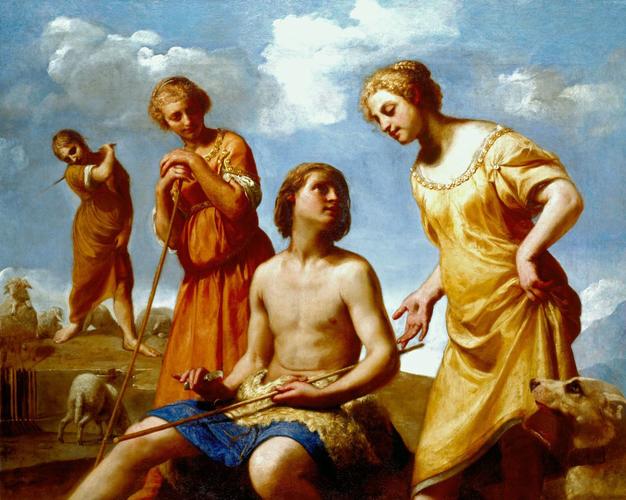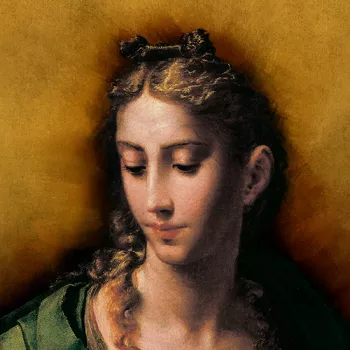Jacob Peeling the Rods c.1650
Oil on canvas | 148.8 x 186.5 cm (support, canvas/panel/stretcher external) | RCIN 406088
-
Jacob agreed with his father-in-law, Laban, that he would have all the speckled sheep and Laban the plain white ones. Jacob put striped rods in their drinking trough. As a result, the flock produced an unusually large number of speckled lambs. The rich tonal contrasts and atmospheric light here show the effect of Venetian art on Cagnacci's work.
The subject of this painting is taken from Genesis 30: 37. Jacob has married both of Laban's daughters, Leah and Rachel (seen here flanking him), and has negotiated half of Laban's flocks as dowry. Son- and father-in-law have arranged the division according to a simple formula: all speckled sheep and goats are Jacob's and all pure white ones are Laban's. Jacob decides to tip the odds in his favour and he prepares striped switches (in the centre foreground), whips the ewes with them (in the background) and immerses the sticks in the drinking trough (in the left foreground) so that the ewes see them as they drink. All Jacob's efforts at genetic modification mean that the flock produce a large number of speckled lambs. The subject is unusual in seventeenth-century Italian painting, and Cagnacci's inventive composition draws attention to the figures in the foreground, while the narrative events of the Old Testament story are depicted in the background.
The scene takes place in an idyllic pastoral landscape with a low horizon framed by a vast and luminous sky. Cagnacci has expertly modelled the figures through the use of tonal contrasts and atmospheric light so that they stand, lit against the vast sky that dominates the background behind them. Typical of Cagnacci's Venetian period, this painting demonstrates the artist's skill at combining warm colours with heightened chiaroscuro in a naturalistic manner. Indeed, the stylistic qualities of this work date it to the 1650s, during the artist's later years in Venice and before his move to Vienna. In particular, many similarities can be noted between the present painting and two other works of Cagnacci's Venetian period, The Virgin Reading a Book (private collection) and the Woman Beating Two Dogs (Borromeo collection, Italy). The female figural types in all three works are particularly analogous, as is the artist's style of painting, dependent on thick impasto applied in an elegant and painterly manner.
Particular similarities can also be drawn between this painting and Cagnacci's other work of the 1650s, specifically in the colours and tones of the background and the sky. Following the recent conservation of the painting, the long-assumed warm yellows and dark orange tones of the background have revealed a bright blue sky filled with white clouds. The artist's signature is painted on the collar of the dog seated in the lower right-hand corner of the canvas.
Additions to the canvas have been noted along the top and right-hand edges of the canvas: Cagnacci may have intended these to be part of the original work, or he may have added them during the course of painting or shortly thereafter to expand the tightly cropped composition. At least two other works by Cagnacci were also painted on canvas made of more than one piece: Martha Rebuking Mary for her Vanity (Norton Simon Museum, Pasadena) is made up of four pieces of canvas sewn together, while Cleopatra (Kunsthistorisches Museum, Vienna) is constructed from seven distinct parts. These other signed works also date from the later period of Cagnacci's career.
The painting appears in Pyne's illustrated Royal Residences of 1819, hanging in the Second Drawing Room at Buckingham Palace (RCIN 922143).
Signed on dog's collar: GVIDO CAGNACCI
Catalogue entry adapted from The Art of Italy in the Royal Collection: Renaissance and Baroque, London, 2007Provenance
Marquis Cassandeni sale, London 1730; bought by Lord Malpas; probably acquired by Frederick, Prince of Wales; recorded by George Vertue in his collection in 1750 (BL add MS 19,027, f. 20); hanging in the Warm Room at Buckingham Palace in 1790
-
Creator(s)
-
Medium and techniques
Oil on canvas
Measurements
148.8 x 186.5 cm (support, canvas/panel/stretcher external)
180.7 x 218.2 x 11.1 cm (frame, external)
Category
Object type(s)
Other number(s)
Alternative title(s)
Jacob, Rachel and Leah










